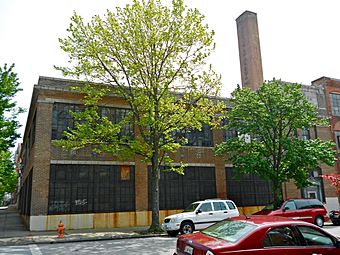Lion Brothers Company Building facts for kids
Quick facts for kids |
|
|
Lion Brothers Company Building
|
|

Lion Brothers Company Building, May 2012
|
|
| Location | 875 Hollins St., Baltimore, Maryland |
|---|---|
| Area | 0.4 acres (0.16 ha) |
| Built | 1885 |
| Architect | Smith & May; Price Constr. |
| NRHP reference No. | 06000781 |
| Added to NRHP | December 7, 2006 |
The Lion Brothers Company Building is an old factory in Baltimore, Maryland. It's also known as the Globe building. This large building used to be home to the Lion Brothers embroidery company. They made cool embroidered patches and designs here! The first part of the building was built in 1885. Over the next 75 years, it grew bigger with more sections added.
Lion Brothers moved out in 1958. After that, other companies used the building. Since 2002, it has been empty. Now, a group called Cross Street Partners plans to fix it up. They want to turn it into a place for new ideas and businesses.
Contents
A Look Back at the Building's History
The Lion Brothers Company started in 1899. Their first location was on South Charles Street in Baltimore. At first, they made many different clothes, like blouses, skirts, and even sailor caps. They were one of many clothing factories in the city.
Moving After the Great Fire
In 1904, a huge event called the Great Baltimore Fire destroyed their factory. Because of this, Lion Brothers had to move. They found a new home at 875 Hollins Street. This building was once a stable and hall owned by John Cowan.
Becoming an Embroidery Expert
In 1911, Lion Brothers bought the Hollins Street building. Around this time, they stopped making finished clothing. Instead, they focused on making embroidered emblems and patches. This was their special skill!
Their new location in West Baltimore was different from other clothing businesses downtown. It had several benefits:
- It was far from the busy downtown area that had been badly damaged by the 1904 fire.
- There were many working-class people nearby who could work at the factory.
- It was close to where the company owners lived.
- Making embroidered emblems was a unique business. It didn't need to be right next to other clothing companies.
Growing Bigger During Wartime
The need for uniforms during World War I helped the company grow a lot. By 1920, the original three-story building was too small. Instead of moving again, they decided to expand right where they were. They eventually took up almost the entire city block!
In 1920, they built a new section that doubled the factory's size. This made it the largest embroidery factory south of New York. Lion Brothers also bought four large embroidery machines. These machines cost a lot of money, almost three times more than the new building itself!
The new building was designed by a famous Baltimore architecture firm, Smith & May. It was built by Price Construction Company. The ground floor was used for machines. The upper floor was for designing and hand embroidery. It had big windows to let in lots of natural light.
More Expansions and New Owners
Over the next 30 years, the factory grew three more times. In 1935, they added another section that looked much like the 1920 addition. In 1948, they added an office and warehouse.
In 1958, the company moved to a larger site in Owings Mills, outside Baltimore. By then, Lion Brothers was the biggest maker of embroidered emblems in the world! They had 250 employees and were still owned by the Lion family.
After Lion Brothers moved, the building was sold in 1961 to Marcus & Farber, another clothing company. Later, in 1978, it was sold to Leon Zimmerman, who owned Globe Screen Printing. Globe Screen Printing moved out in 2002, and the building has been empty since then.
A Historic Landmark
The Lion Brothers Company Building was added to the National Register of Historic Places in 2006. This means it's recognized as an important historic place.
In 2015, a group called Cross Street Partners started planning to fix up the building. They wanted to create office spaces and places for new ideas. In 2017, the University of Maryland, Baltimore County's art program became one of the first tenants in the complex.
- Lion Brothers Company Building, Baltimore City, including photo from 2004, at Maryland Historical Trust




